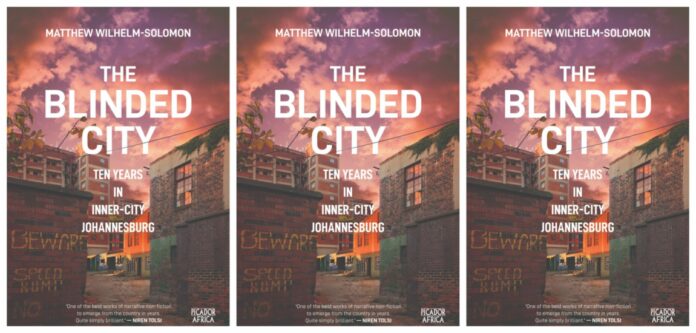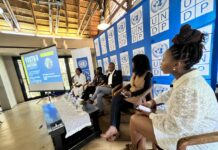If you’re interested in the politics of the Johannesburg inner-city, then Matthew Wilhelm-Solomon’s book is a must-read. The Blinded City is a narrative style nonfiction book which takes an in-depth look at ten years of Johannesburg’s inner-city.
There are many important things to point out about The Blinded City. There is the storytelling, the in-depth research (over 10 years worth!), the writing and the important issues being discussed. However, one thing that stands out is the faces and stories that Wilhelm-Solomon gives to the people that make up Johannesburg’s inner city.

READ MORE:
Constitutional Court encourages change in attitude towards Joburg’s urban poor
Walk, drive or just pass through Joburg’s streets and one is likely to see many different people standing at robots – asking for help whether it’s money or food or clothes. Oftentimes, people would either stop to give help, or roll up their window or just ignore the people. In The Blinded City, Wilhelm-Solomon takes the reader into the lives of the people who live in the city. He talks a lot about the post-apartheid South Africa and what characterises it including the “most intractable issue” which is urban housing.
A few days after completing the book, The Daily Vox team headed to Wits University to interview Wilhelm-Solomon. On the drive over to the university through the inner-city, many of the areas that are mentioned in the book formed the landscape of the journey. Having completed the book brought a new consciousness to the drive.
RELATED:
Trendy Maboneng and the Jeppestown evictions nobody cares about
One of the main things that defines the living of inner-city residents is precarity. This is something Wilhelm-Solomon mentions several times during the interview. It is a perfect way to understand the conditions. The residents of the inner-city are constantly on edge. They are at the mercy of the government, the municipality, the police, criminals and landlords. Sometimes all of these can converge at the same time.
One of those things is most definitely the way the most economically marginalised people in society were rendered invisible for the most part. For most middle-class people, especially those living in the suburbs, they get to leave the inner-city if they work there and head home to their cushy and comfortable houses. They get to forget about the people living in the abandoned buildings of the inner city and the harsh realities of their lives.
READ MORE:
Excluding people from public spaces, from Sharpeville to Maboneng
But that’s not the point. The book is not for middle-class South Africans to feel guilty.
The point actually is that the people who live in the inner city have been rendered invisible in all aspects of life including economic, social and political. As Wilhelm-Solomon outlines in his book but seen through the many policies from politicians and governments, it’s about them without them. They do not have access to basic services. Their living conditions are worse than those of people living in war zones. They don’t have a political voice. More importantly, they are seen as criminals, hijackers and lawbreakers.
READ MORE:
Five moves by Herman Mashaba that we’re not so sure about
One interesting thing that comes up in the book is that Wilhelm-Solomon grapples with the idea of the role of the research and his positionality as a white man. He said he made sure to try and create relationships with the people he spoke to as opposed to imposing on the spaces. Many of the people he spoke to in the book over the ten years are people he has kept in contact with. He also plans to give books to people mentioned in the book.
“Of course as a white male going into these spaces, that’s something that I was aware of from the outset, something that I would have to navigate…” he said.
In The Blinded City, Wilhelm-Solomon takes special care to address these stereotypes. He relates the stories and lives of the people he encounters during his research. While addressing the very important issue of urban housing and regeneration, the human element enhances the pertinence of it. The book shows how despite the hardship and difficulties and violence the people of the inner-city living experience, they are resilient in their goal to build a better life for themselves and their loved ones. The criminality and unlawful elements exist and cannot be denied. However, the book challenges readers to look beyond the surface and question their own prejudices as well as the “truths” told by those in power.
RELATED:
Poor people can’t afford regeneration in Jeppestown
During the interview, Wilhelm-Solomon expressed his wish that he told the stories of the people who entrusted him with integrity. That’s something that shines through in the book. There is sincerity and truthfulness in the storytelling of the book. In his own words, the books bring “a nuanced story around issues of unlawful occupation, migration, gender-based violence and so on”.
This is a book for everyone to read. It is important. It is eye-opening and mostly it shows that building a better city means taking a nuanced look at the situation. There cannot be as Wilhelm-Solomon mentioned “political deflection” and “scapegoating”. There is a need for a paradigm shift and a rethinking of policing and the system as a whole.
READ MORE:
Doornfontein Building Collapse: City Can’t Escape Safe Housing Responsibility, SERI Says
Building better cities and a better Johannesburg is not about creating smarter cities. It should be about providing sustainable, affordable and safe housing. After all, the benefits of that will help everyone especially the inner-city residents and the most marginalised.
READ MORE:
Mashaba points finger at civil society: #JhbFire “was bound to happen”
Published by Pan Macmillan, the book is available online and at all good bookstores.









